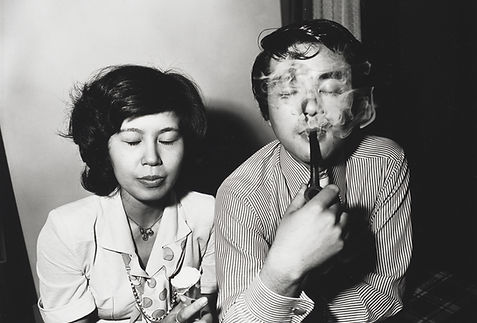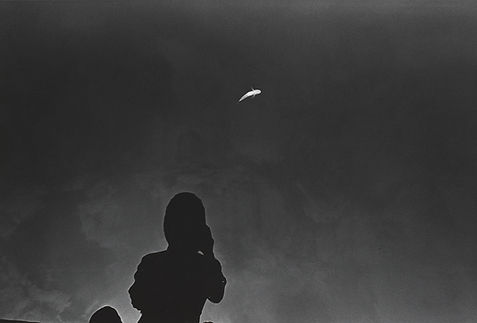ARTS & COLLECTIBLES
ARTS & COLLECTIBLES
POSTWAR JAPAN
A major exhibition of postwar Japanese avant-garde photography Farewell Photography: The Hitachi Collection of Postwar Japanese Photographs, 1961-1989 explores the radical reconsideration of the photographic medium through outstanding works from the Center for Creative Photography.

Taku Aramasa, Yurio Hasegawa (Japanese), Zenji Watanabe (Japanese), Harunaga Hasegawa (Japanese), 1984. Gelatin silver print. Center for Creative Photography, University of Arizona: Purchase, with matching funds from Hitachi America, Ltd. © AMARASA Taku
Phoenix Art Museum announces the recent opening of a new exhibition that explores the radical evolution of photography in post-World War II Japan—featuring works from 1961 through 1989 by 19 contemporary Japanese photographers who played integral roles in shaping Japanese photography of the postwar period. Farewell Photography: The Hitatchi Collection of Postwar Japanese Photographs, 1961-1989, displays 87 of these prints gifted by the Hitachi Corporation to the Center for Creative Photography together for the first time. The exhibition, curated by Audrey Sands, the Norton Family Curator of Photography, and Adam Monohon, former Curatorial Assistant at the Center for Creative Photography, will be on view through June 26, 2022, in the Norton Family Photography Gallery in the Museum’s Katz (South) Wing.

Ikkō Narahara, Japanesque #53, Sojiji, Japan, 1969. Gelatin silver print. Center for Creative Photography, University of Arizona: Gift of the artist. © Ikko Narahara

Kikuji Kawada, New Couple Who Closed Their Eyes, Tokyo, 1974. Gelatin silver print. Center for Creative Photography, University of Arizona: Purchase, with matching funds from Hitachi America, Ltd. © Kikuji Kawada
“We are excited to collaborate with the Center of Creative Photography once again to bring this unique aspect of their collection to our audiences in Phoenix and beyond,” said Mark Koenig, the Interim Sybil Harrington Director and CEO of Phoenix Art Museum. “Farewell Photography provides a unique opportunity for Museum visitors to experience a category of photography that helped shape the photographic medium for Japan and across the globe, a glimpse into the evolution of the medium as it was shaped by the experience of war and the beginning of the nuclear age.”
As Japan recovered from the devastation wrought by the global conflict and U.S military occupation (1945-1952) in the decades following World War II, numerous Japanese photographers undertook an aggressive reassessment of the photographic medium. New non-conformists broke from photojournalism’s norms of objective depiction. They emerged, adopting new ideals of a radically expressive, subjective, and critical approach that became known as are-bure-boke (literally translated to “rough, blurred, and out-of-focus”). This new aesthetic responded to the realities of a rapidly changing, modernizing, and westernizing Japan, struggling to recover from the war and the horrors of nuclear destruction and questioned traditional associations of photography with truth, patriotism, and complacency.

Michiko Kon, Yellowtail and Comb, ca. 1985. Gelatin silver print. Center for Creative Photography, University of Arizona: Purchase, with matching funds from Hitachi America, Ltd. © Michiko Kon, courtesy Robert Mann Gallery

Toshio Shibata, Chubu Sangaku National Park, Ootaki Village, Nagano Prefecture, May 1986, 1986. Gelatin silver print. Center for Creative Photography, University of Arizona: Purchase, with matching funds from Hitachi America, Ltd. © Toshio Shibata
In 1988 and 1990, through grants from the Hitachi Corporation, the Center for Creative Photography (CCP) acquired 87 works by 19 contemporary Japanese photographers who promoted are-bure-boke and played integral roles in shaping Japanese photography of the postwar period. Farewell Photography: The Hitachi Collection of Postwar Japanese Photographs, 1961-1989, displays all 87 of these prints from CCP’s collection together for the first time since they were acquired more than 30 years ago. Featured works include gritty, starkly contrasted, black-and-white photographs from Daidō Moriyama’s seminal 1972 photobook, Farewell Photography, from which the exhibition takes its name, which heralded photography’s departure from the medium’s previous commitments to propriety, stillness, and objective rendering of facts. Additional artists showcased throughout the exhibition include Masahisa Fukase, Shōmei Tōmatsu, Miyako Ishiuchi, Eikoh Hosoe, and others. Miyako Ishiuchi is a pivotal figure in Japanese photography as a woman practicing in a male-dominated field. Her groundbreaking works have been influential for a younger generation of women photographers, most notable for merging political messages with a highly personal and subjective approach.

Kikuji Kawada, Floating Fish and a Photographer, Todabashi, 1975. Gelatin silver print. Center for Creative Photography, University of Arizona: Purchase, with matching funds from Hitachi America, Ltd. © Kikuji Kawada

Masahisa Fukase, Ishikawamon, Kanazawa, 1977. Gelatin silver print. Center for Creative Photography, University of Arizona: Purchase, with matching funds from Hitachi America, Ltd. © Masahisa Fukase, courtesy Robert Mann Gallery
“This collection brings an opportunity to dig into some previously unexplored strengths of CCP’s collection. Not very many institutions, aside from the leading institutions of photography, have as concentrated a collection in this particular area,” said Audrey Sands, the Norton Family Assistant Curator of Photography, who curated the exhibition. “I hope this exhibition introduces viewers to this special group of photographers who represented this radical new vision. I want to highlight how provocative this style was during a loaded and controversial political moment in Japan. When I think about our audience in Phoenix, I want to broaden the view beyond the North American-centric story of the history of modern photography and look at this extraordinary rich and edgy cultural output and the way that photography was used as protest. To have a more global understanding of this period of social unrest and of a generation that was challenging governments and norms is, I think, a critical vocabulary for us to better understand our own time.”

Join our mailing list to receive curated updates, special features, and invitations to events that define the world of the discerning few.
Sign up today and never miss what’s next.






